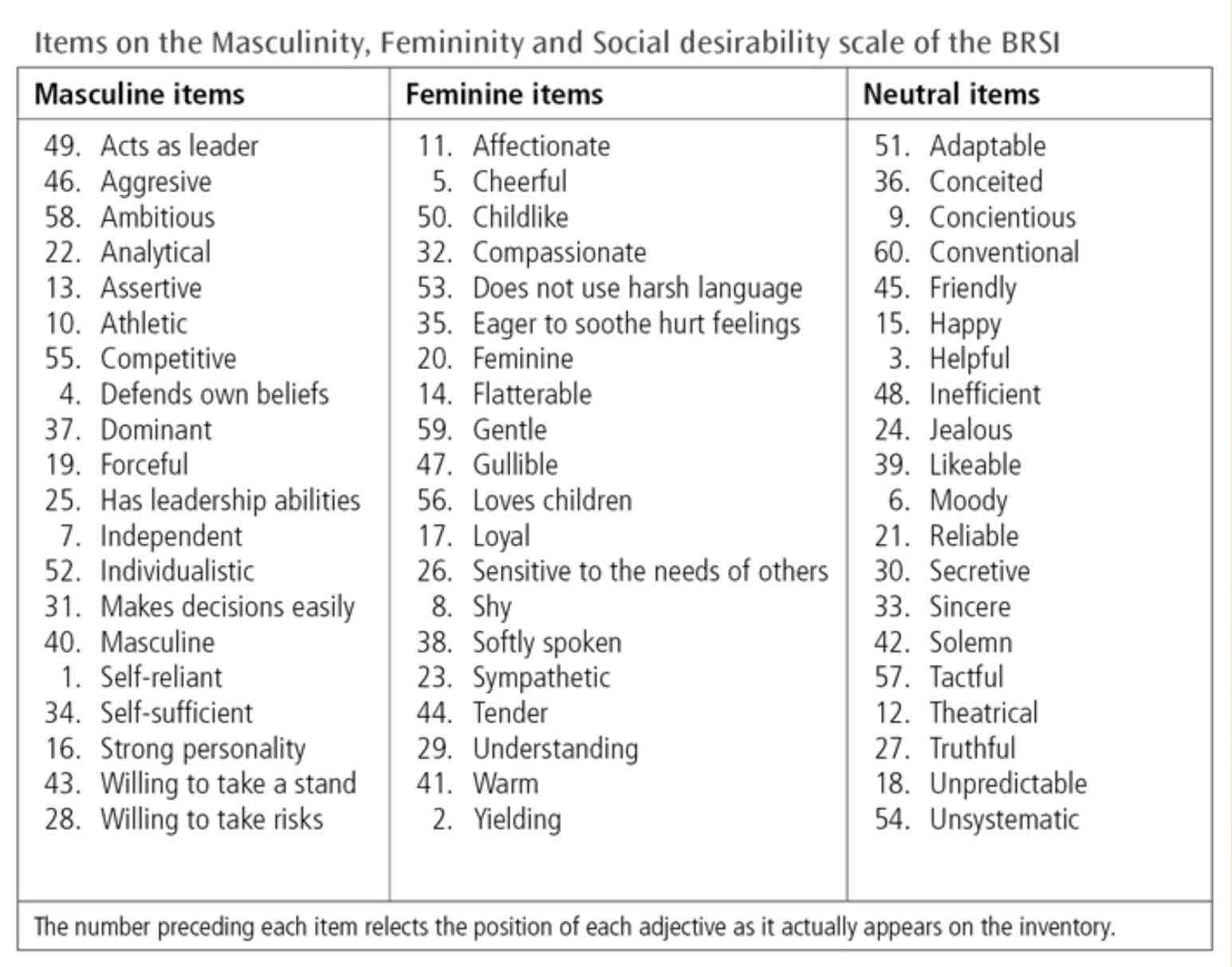Sex, gender, sex-role stereotypes and androgyny
1/17
There's no tags or description
Looks like no tags are added yet.
Name | Mastery | Learn | Test | Matching | Spaced |
|---|
No study sessions yet.
18 Terms
Define sex
Biological differences between males and females including chromosomes, hormones and anatomy
Define gender
Tre physiological, social and cultural differences between men and women including attitudes, behaviours and social roles
What is the difference between sex and gender?
Sex is innate (biological) and gender is at least partly environmental
This would suggest that sex cannot be changed
A person’s gender is seen as a person’s psychological status - a person can be more masculine or feminine depending on the social context they are in
Describe Imperato-McGinley et al (1974) study into the Batista family
Family that lived in the Dominican Republic
4 of the children were identified female at birth and raised as such - they were actually genetically male
This was a very rare genetic condition meant that when hormonal changes occurred in puberty, their vaginas closed over and they developed penises
All of the boys abandoned their female gender and identified as male - this suggests gender is flexible
Define sex-role stereotypes
A set of of beliefs and preconceived ideas about what is expected or appropriate for men and women in a given society or social group
How are sex-role stereotypes reinforced?
By parents, teachers and the media
Describe Furnham and Farrager (2000) research into sex-role stereotypes
Analysed TV adverts
Findings: men more likely to be shown in autonomous roles in professional contexts whereas women were depicted in familial roles within domestic settings
Describe research that goes against untrue sex-role stereotypes
Research has find that women cope better with multi-tasking than males but there is no strong evidence to imply that women struggle to control their emotions in the work place
Define androgyny
Displaying a balance between masculine and feminine characteristics
Describe androgyny
The term comes form ‘andro’ meaning male and ‘gyny’ meaning female
Both males and females can be described as being androgynous
E.g., an individual who is aggressive & competitive at work but a kind and sensitive parent is typically displaying male and female characteristics
Androgynous individuals tend to have more positive psychological health outcomes
What does BSRI stand for?
Bem Sex Role Inventory
Divide the 60 traits of the BSRI
20 masculine
20 feminine
20 neutral

Name the 2 dimensions of the BSRI
Masculinity-femininity
Androgynous-undifferentiated
Describe how the BSRI works
Self-report with 60 items
Rated on 7 point likert scale
1 is ‘never true of me’ and 7 ‘always true of me’
The BSRI is an indicator of psychological well-being and mental health rather than just having masculine or feminine qualities
There is supporting evidence for the correlation between androgyny and good health. Describe how this is a strength
Burchardt & Serbin (1982): provided supporting research for a positive correlation between androgyny and good mental health
In relation to lower levels of depression in androgynous females and androgynous males scored lower on introversion than feminine females
Peters and Cantrell (1993): used the BSRI to provide supporting evidence that androgynous females had the best quality relationships
This supports the idea of a positive condition and it being associated with higher interpersonal functioning than inviduals who are predominantly masculine or feminine
This is a strength since it supports the importance of androgyny as an indicator of positive mental health and increases the validity of the BSRI as a measure of psychological well-being
The BSRI has good test-retest reliability. Describe how this is a strength
Research has demonstrated high correlation co-efficient of .76 and .94 over a 4-week period
Furthermore, a shorter version of the test which has 30 items has improved test-retest reliability with a correlation of .90
The BSRI was also developed by asking 50 male and 50 female judges to rate 200 traits
The test was also piloted with over 1000 students and results corresponded with the Ps own description of their gender identity
This is a strength since it suggests the BSRI is a reliable way to measure androgyny
Androgyny is not always associated with positive mental health. Describe how this is a weakness
Androgynous individuals may demonstrate negative masculine characteristics such as aggression and negative female characteristics such as being too timid in certain situations
Adams and Sherer (1985) and other researchers have argued that people who display a greater proportion of masculine traits are better adjusted as these are more highly valued in some societies
This is a weakness since it criticises Bem’s idea of positive psychological well-being
The BSRI lacks temporal validity. Describe how this is a weakness
It was created by data generated from American students in the 1970s
Typical gender behaviour may have changed since then
E.g., contemporary research was conducted on a group of 400 undergraduates who were asked to rate the items on the BSRI as masculine or feminine
Findings: only two of the items were still considered to be masculine or feminine
The panel of judges was also from the USA - individualist notions of maleness and femaleness may not be shared across all societies/cultures
This is a weakness since it suggests the BSRI is outdated as a measure of androgyny